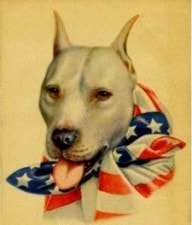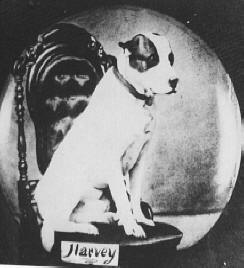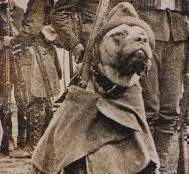A Symbol of American Pride
Throughout history, Pit Bulls have been mascots for the American military. In the early twentieth century, Pit Bulls were so respected for their loyalty, determination and bravery they were chose to represent America in WWI on posters used for recruitment and to sell war bonds.
Some of the most famous military Pit Bulls are:
Stubby
The first decorated canine war hero and the only dog to be promoted to sergeant was an American Pit Bull Terrier, Stubby. Born in 1917, he wandered into a Connecticut national Guard encampment on the Yale University campus. A scrawny little pup of about four weeks, he was found by John Robert Conroy who smuggled his beloved companion abord the troop ship, the SS Minnesota. Once Stubby learned to salute, his military career began. He served beside Conroy in the 102nd Infantry 26th Yankee division, during WWI, in the trenches in France. There Stubby would seek out wounded soldiers, which were significantly less because Stubby could hear the whine of incoming artillery shells before the humans, and would let his unit know when to duck for cover. After being gassed, Stubby began warning his unit of poison gas attacks. There is no way to know how many American soldiers he saved, but the respect he was given by the U.S. after the war is a clear indicator of how valuable Stubby was to the men of his unit. During his military career, Stubby aided in the capture of a German spy and severely injured by shrapnel. He was sent to the Red Cross hospital for surgery, awarded the Purple Hear and sent back to his regimen. After the battle for the French village of Domremy, the grateful women of the township fashioned a hand sewn chamois coat to display Stubby's service chevrons, metals, pins and buttons. This became his recognized trademark and is now on display at the Smithsonian Museum.
In his lifetime, Stubby was invited to the White House by three pResidents, Woodrow Wilson, Warren Harding and Calvin Coolidge. In 1921, John Conroy and Stubby headed to Georgetown to enroll in law school were Stubby became a practicing Hova. He served several terms as mascot to the football team. Between halves, Stubby would nudge a football around the field with his nose to the delight of the crowd. His performance is deemed the inspiration that started elaborate half-time shows at football games across the country. Stubby was a true American Pit Bull Terrier until his death in John Conroy's arms of old age April 4, 1926.
Jack Brutus
Jack Brutus was a fine soldier serving during the Spanish – American War. He became the official mascot for Company K, First Connecticut Volunteer Infantry. “Old Jack”, as he was known, and his unit spent most of the war encamped at various places in the United States providing coastal defense from Maine to Virginia. Old Jack died of spinal troubles in 1898.
Old Harvey
Old Harvey was the mascot for the 104th Ohio Infantry. He was beloved for the companionship and humor he provided the troops. It is said Harvey would should his great love for music by swaying from side to side while the soldiers sang campfire songs in the evening. He was wounded in two battles, but survived. Harvey's tag read, "I am Lieutenant D.N. Stearns' Dog. Who's Dog Are You?"
The 104th had a portrait of Harvey commissioned so he could still part of their reunions are his death. Today, Harvey is remembered by the Western Reserve Historical Society in Cleveland where a portrait of the troop features a proud Harvey posing with his fellow soldiers.
Jack
This brown and white bullie breed who understood bugle calls was the mascot for the 102nd Pennsylvania Infantry. This fine soldier was a dependable member of his unit. His career spanned nearly all the regiment's battles in Virginia and Maryland. He was present at the Wilderness campaigns, Spotsylvania, and the siege of Petersburg. Jack's duty was to seek out the dead and wounded of his regiment once they gunfire silenced. He was wounded severely at the battle of Malvern Hill. Although he was able to escape a capture twice and became the only dog to be traded as a prisoner of war, when during his second capture, he was exchanged for a Confederate soldier. Jack disappeared shortly after being presented a silver collar purchased by his human comrades and was believed to be a victim of theft.
Sallie
Sallie, a brindle Staffordshire Bull Terrier, was regimental mascot for the 11th Pennsylvania Volunteer Infantry during the Civil War. Sallie came to 1st Lt William R Terry when she was but four weeks old. Always by his side, Sallie grew up among the men of the regiment following them on marches and into battle. At the battle of Gettysburg, Sallie was separated from her unit. Unable to find her way, she returned to the Union battle line at Oak Ridge where she stood guard over the dead and wounded. Sallie continued her faithful service until she was struck in the head by a bullet and killed instantly during the battle of Hatcher's Run in 1865. She was buried on the battlefield while surrounded by enemy fire. In appreciation of her loyal devotion, a monument of Sallie now stands in Gettysburg.
Throughout history, Pit Bulls have been mascots for the American military. In the early twentieth century, Pit Bulls were so respected for their loyalty, determination and bravery they were chose to represent America in WWI on posters used for recruitment and to sell war bonds.
Some of the most famous military Pit Bulls are:
Stubby
The first decorated canine war hero and the only dog to be promoted to sergeant was an American Pit Bull Terrier, Stubby. Born in 1917, he wandered into a Connecticut national Guard encampment on the Yale University campus. A scrawny little pup of about four weeks, he was found by John Robert Conroy who smuggled his beloved companion abord the troop ship, the SS Minnesota. Once Stubby learned to salute, his military career began. He served beside Conroy in the 102nd Infantry 26th Yankee division, during WWI, in the trenches in France. There Stubby would seek out wounded soldiers, which were significantly less because Stubby could hear the whine of incoming artillery shells before the humans, and would let his unit know when to duck for cover. After being gassed, Stubby began warning his unit of poison gas attacks. There is no way to know how many American soldiers he saved, but the respect he was given by the U.S. after the war is a clear indicator of how valuable Stubby was to the men of his unit. During his military career, Stubby aided in the capture of a German spy and severely injured by shrapnel. He was sent to the Red Cross hospital for surgery, awarded the Purple Hear and sent back to his regimen. After the battle for the French village of Domremy, the grateful women of the township fashioned a hand sewn chamois coat to display Stubby's service chevrons, metals, pins and buttons. This became his recognized trademark and is now on display at the Smithsonian Museum.
In his lifetime, Stubby was invited to the White House by three pResidents, Woodrow Wilson, Warren Harding and Calvin Coolidge. In 1921, John Conroy and Stubby headed to Georgetown to enroll in law school were Stubby became a practicing Hova. He served several terms as mascot to the football team. Between halves, Stubby would nudge a football around the field with his nose to the delight of the crowd. His performance is deemed the inspiration that started elaborate half-time shows at football games across the country. Stubby was a true American Pit Bull Terrier until his death in John Conroy's arms of old age April 4, 1926.
Jack Brutus
Jack Brutus was a fine soldier serving during the Spanish – American War. He became the official mascot for Company K, First Connecticut Volunteer Infantry. “Old Jack”, as he was known, and his unit spent most of the war encamped at various places in the United States providing coastal defense from Maine to Virginia. Old Jack died of spinal troubles in 1898.
Old Harvey
Old Harvey was the mascot for the 104th Ohio Infantry. He was beloved for the companionship and humor he provided the troops. It is said Harvey would should his great love for music by swaying from side to side while the soldiers sang campfire songs in the evening. He was wounded in two battles, but survived. Harvey's tag read, "I am Lieutenant D.N. Stearns' Dog. Who's Dog Are You?"
The 104th had a portrait of Harvey commissioned so he could still part of their reunions are his death. Today, Harvey is remembered by the Western Reserve Historical Society in Cleveland where a portrait of the troop features a proud Harvey posing with his fellow soldiers.
Jack
This brown and white bullie breed who understood bugle calls was the mascot for the 102nd Pennsylvania Infantry. This fine soldier was a dependable member of his unit. His career spanned nearly all the regiment's battles in Virginia and Maryland. He was present at the Wilderness campaigns, Spotsylvania, and the siege of Petersburg. Jack's duty was to seek out the dead and wounded of his regiment once they gunfire silenced. He was wounded severely at the battle of Malvern Hill. Although he was able to escape a capture twice and became the only dog to be traded as a prisoner of war, when during his second capture, he was exchanged for a Confederate soldier. Jack disappeared shortly after being presented a silver collar purchased by his human comrades and was believed to be a victim of theft.
Sallie
Sallie, a brindle Staffordshire Bull Terrier, was regimental mascot for the 11th Pennsylvania Volunteer Infantry during the Civil War. Sallie came to 1st Lt William R Terry when she was but four weeks old. Always by his side, Sallie grew up among the men of the regiment following them on marches and into battle. At the battle of Gettysburg, Sallie was separated from her unit. Unable to find her way, she returned to the Union battle line at Oak Ridge where she stood guard over the dead and wounded. Sallie continued her faithful service until she was struck in the head by a bullet and killed instantly during the battle of Hatcher's Run in 1865. She was buried on the battlefield while surrounded by enemy fire. In appreciation of her loyal devotion, a monument of Sallie now stands in Gettysburg.









